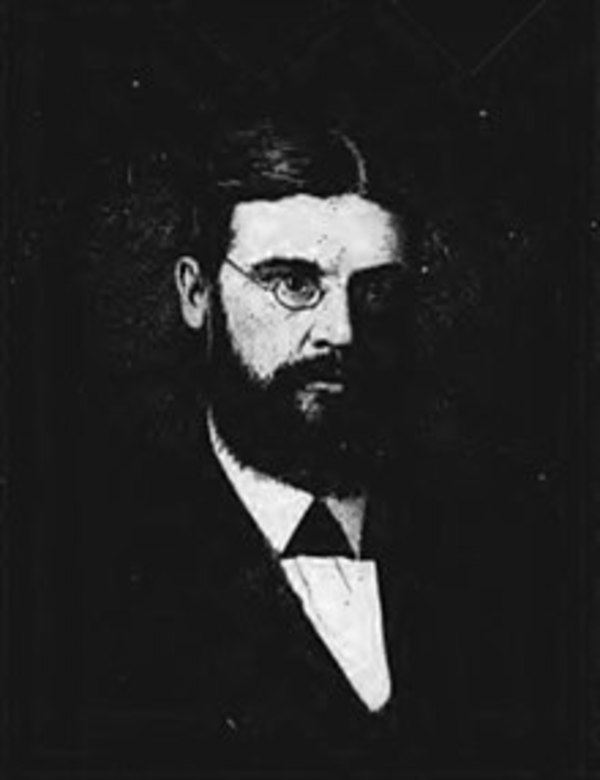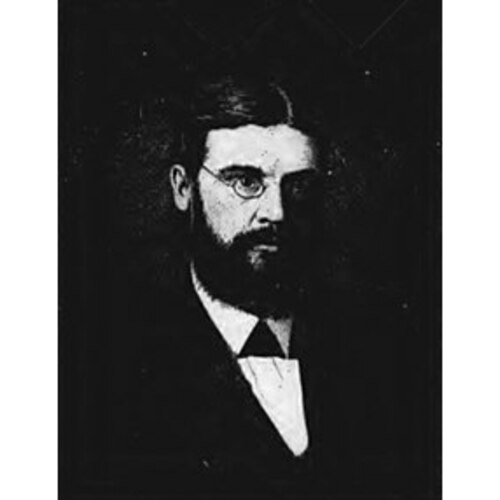
Source: Link
DE MILLE, JAMES (the family used DeMill, but he wrote under De Mille, and used this name after 1865), author and professor; b. at Saint John, N.B., probably on 23 Aug. 1833, third child of loyalists Nathan Smith DeMill and Elizabeth Budd; d. at Halifax, N.S., 28 Jan. 1880, at the age of 47.
Nathan DeMill was a prosperous merchant, ship-owner, and lumberman in Saint John, N.B. He was a man of strong principles and a strict abstainer, called “cold-water DeMill” by his contemporaries. He left the Church of England to become a Baptist, and was active on the board of governors of Acadia College which was chartered in 1841. James De Mille and his brothers were educated at Horton Academy, Wolfville, before continuing at Acadia. Their adventures at the academy, real or imaginary, form the substance of an excellent set of boys’ books, The “B.O.W.C.” Series. Taking place in and around Minas Basin or celebrating great Maritime events such as the Miramichi fire, these adventures of the Brothers of the White Cross were published between 1869 and 1873.
James matriculated at Acadia College in 1849. The following year he and his elder brother Elisha Budd DeMill set off on a year’s travel, going by boat to Boston, overland to Quebec, and there boarding one of their father’s ships for England. They went on a walking trip in England and Scotland, crossed to France, and spent several months in Italy. The experiences of this year profoundly affected James – most of his many novels reflect a knowledge of places, people, and languages not his own – and left him with a lifelong love of Italy.
On his return to North America he transferred to Brown University, Providence, Rhode Island, and graduated with an ma, in 1854. Then followed some eventful but frustrating years. He travelled to Cincinnati to wind up a wildcat mining concern in which Acadia College money was involved; in 1856 in Saint John he and a partner started a book business, which failed leaving many debts; his father, too, suffered business reverses.
In 1859 James De Mille married Elizabeth Ann Pryor, daughter of Dr John Pryor*, first president of Acadia College. He was appointed professor of classics at Acadia in 1860, thus beginning a career as an outstanding teacher and scholar. He instituted the classical honours course and is supposed to have encouraged his students to use Latin as a language of conversation. He also taught Italian to interested students. The first of his books, Martyrs of the Catacombs, about first-century Rome, which he had written in 1858, was published in 1864.
In 1865 he moved to Halifax to become professor of history and rhetoric at Dalhousie College, having in the same year refused an appointment as superintendent of education for Nova Scotia. After moving to Halifax, he returned to his father’s first affiliation, the Church of England, and published a pamphlet on its early history. He spent the rest of his life in Halifax, enhancing his reputation as a teacher and publishing, at the rate of about two a year, a long series of books. Obviously he wrote his novels under tremendous pressure, perhaps driven by the debts incurred during his business venture. During this time he also wrote The elements of rhetoric (1878), a well-planned and gracefully executed textbook.
His novels originally appeared serially in American magazines before being published as books in New York or Boston by Harper, Appleton, and other publishers. The majority of the novels show signs of haste and of a desire to satisfy the demand of readers of popular fiction for mystery and high adventure. Helena’s household, an early novel that De Mille had the leisure to write with care, was much admired as giving an accurate picture of Roman family life. Almost all his novels show a delightful sense of humour and parody and a good eye for national absurdities as well as national characteristics. His merry story, The Dodge Club, published in 1869, and anticipating Mark Twain’s Innocents abroad, splendidly caricatures a group of American travellers (the Dodge Club of the title), exposed to stock continental situations; a scene in which a senator woos a countess by reading Isaac Watts’ poetry is magnificent. De Mille’s second series of boys’ books, The young Dodge Club, also exploited this vein. In Lady of the ice he enjoys equally the foibles of the young officer class stationed in Quebec. The posthumous, anonymously published, and probably unfinished book, A strange manuscript found in a copper cylinder, has been much admired as a Swiftian satire. A long mystical poem called Behind the veil was edited by Archibald MacMechan* and published in 1893.
James De Mille must have been a delightful person: extremely intelligent with artistic and literary abilities of a high order. The story told of his fishing trips with another Dalhousie professor on which they conversed in Latin as the only language that would not “profane the mysteries” of fishing, is typical of the reminiscences of students and friends. His interests were varied: he wrote and delightfully illustrated a translation of Homer for his four children; he owned books printed in nearly a dozen languages, from Sanskrit to Icelandic; and he expressed a deep concern for the future of higher education in his community.
De Mille has been generally too much forgotten. During his lifetime he was one of Canada’s few well-known writers, but today he is perhaps best known for a poem, “Sweet maiden of Passamaquoddy,” that first appeared in a serialized story, “Minnehaha Mines,” and has since been reprinted in many anthologies. Although many of his writings are of little interest except as examples of 19th-century adventure stories, a few – The Dodge Club, for example – deserve to be reprinted and read. His books for boys would still delight a young reader.
[James De Mille’s birth date has been the subject of disagreement among various authors. The year 1833 was chosen for several reasons: 1836, the year usually used, would have made De Mille too young to matriculate at Acadia in 1849 since the college required a minimum age of 15; 1833 is quoted on De Mille’s tombstone; Archibald MacMechan,who knew the De Mille family, used 1833. m.t.]
Some of James De Mille’s works include: The “B.O.W.C.”: a book for boys (Boston, 1869); Behind the veil, a poem (Halifax, 1893); The boys of Grand Pré School (Boston, 1871); A comedy of terrors (Boston, 1872); The Dodge Club; or, Italy in 1859 (New York, 1869); The early English church (Halifax, 1877); The elements of rhetoric (New York, 1878); The lady of the ice (New York, 1870); “Minnehaha Mines,” The Dominion: True Humorist (Saint John, N. B.), 16 April 1870; An open question, a novel (New York, 1873); A strange manuscript found in a copper cylinder (New York, 1889; Toronto, 1910); “Professor De Mille’s inaugural address,” Dalhousie Gazette (Halifax), 15 Nov. 1873.
Dalhousie University Library (Halifax), Special Collections, James De Mille, Family correspondence and business papers, 1856–80; Journal of Elisha B. De Mille, 1850–51; Notebook of James De Mille when attending Brown University; manuscripts of several of James De Mille’s works. Acadia College (Wolfville, N.S.), Catalogue of the officers and students (Halifax), 1861–62, 3–4, 9, 20; 1863–64, 11. L. J. Burpee, “Who’s who in Canadian literature, James De Mille,” Canadian Bookman (Toronto), VIII (1926), 203–6. R. W. Douglas, “James De Mille,” Canadian Bookman (Toronto), IV (1922), 39–44. A. M. MacMechan, “De Mille, the man and the writer,” Canadian Magazine (Toronto), XXVII (1906), 404–16. George Patterson, More studies in Nova Scotian history (Halifax, 1941), 120–48.
Cite This Article
Minerva Tracy, “DE MILLE, JAMES,” in Dictionary of Canadian Biography, vol. 10, University of Toronto/Université Laval, 2003–, accessed December 29, 2025, https://www.biographi.ca/en/bio/de_mille_james_10E.html.
The citation above shows the format for footnotes and endnotes according to the Chicago manual of style (16th edition). Information to be used in other citation formats:
| Permalink: | https://www.biographi.ca/en/bio/de_mille_james_10E.html |
| Author of Article: | Minerva Tracy |
| Title of Article: | DE MILLE, JAMES |
| Publication Name: | Dictionary of Canadian Biography, vol. 10 |
| Publisher: | University of Toronto/Université Laval |
| Year of publication: | 1972 |
| Year of revision: | 1972 |
| Access Date: | December 29, 2025 |




